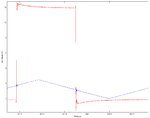Veriloger
Newbie level 4
Hi,
I have the following waveform coming out of a MOSFET driver. As shown as red in the image. How do i go about cleaning up the signal without loosing the sharp rise/fall times? The very sharp rising/falling edges are important, which is why i don't want them to slow down.
In this circuit, i have the output of the driver connected to the gate of an Nch MOSFET via an AC coupling capacitor, a zener (tying gate to source), a resistor (tying gate to source). The traces between each component lead is only a few millimetres long. The longest being from the AC coupling capacitor and the gate of the MOSFET, which is less than 20mm. What are the likely suspects to the cause the distortion?
Also what is the cause of the spikes just before each transition? Is this just internal inductance of the driver?

Thanks
I have the following waveform coming out of a MOSFET driver. As shown as red in the image. How do i go about cleaning up the signal without loosing the sharp rise/fall times? The very sharp rising/falling edges are important, which is why i don't want them to slow down.
In this circuit, i have the output of the driver connected to the gate of an Nch MOSFET via an AC coupling capacitor, a zener (tying gate to source), a resistor (tying gate to source). The traces between each component lead is only a few millimetres long. The longest being from the AC coupling capacitor and the gate of the MOSFET, which is less than 20mm. What are the likely suspects to the cause the distortion?
Also what is the cause of the spikes just before each transition? Is this just internal inductance of the driver?

Thanks